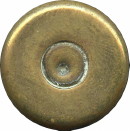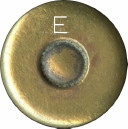The special committee that was set up in February of 1869 by the Royal Navy to re-examine the role and future of machine guns for Land and Naval Service had to consider the role of the Martini Henry cartridge and re-barrelling of all existing Gatlings to accommodate the Martini cartridge. The biggest flaw recognised by the committee was the extreme bottleneck of the .45 Martini cartridge as well as the weight of the weapon because of the larger magazine or hopper and the feed slots on the guns. Initial recommendations by the committee were a reversal in the sense that all new and existing guns, including Martini Henrys be chambered or re-chambered for the .45 Gatling cartridge and following on from this, machine gun trials were arranged, and advertisements issued to which eighteen interested parties responded. From this it seemed clear the .45-inch Gatling was to become the universal one for machine guns and following the rest of the recommendations from the committee, rifle trials were held in 1881 with re-barrelled Martini Henry rifles. After conclusion of these trials, it was recommended in August 1881 that new Martini rifles should be ordered in quantity chambered in the .45 Gatling. These Gatling chambered Martinis were supposed to have been designated as Mark IV rifles.
However, two months later the committee requested that its decision be reconsidered because of misfires with new ammunition. Further to that, separate experiments that were conducted at Enfield in 1880 were done to develop a new rifle and cartridge with a .4-inch diameter and lighter bullets (380 – 390grains) and lighter loads (80 – 85grains). From 1870 onward giant strides were made in rifle and cartridge development in Europe and it was, even with the best of intentions and resources, not always easy to keep abreast of all the developments taking place. The British were at this stage lacking two crucial advances in small arms development, the first being the bolt action design, perfected by Mauser from the original design by Nicholas von Dreyse and secondly a rifle with a magazine capacity, either in a tube underneath the barrel like the Germans were using in the Kropatschek design, which was an improvement on the Henry-Winchester design or the Mannlicher designed box magazine. Therefore, in January 1881 a separate committee was established to follow on from the Enfield trials, and specifically to come up with a design to replace the Martini Henry with a magazine rifle.

The modified Enfield Martini rifle was designed by Col. H J Arbutnot during 1882 and was presented by the Royal Small Arms Factory at Enfield to the Small Arms Committee and was a total redesign from the existing Mk. II and Mk. III Martini Henry rifles. The design was further modified through 1884 and into 1885 and included a quick loader on the right-hand side of the action. There were four designs for the .4-inch cartridge at Enfield dating from mid-1881 which were all heavily tapered and tests were done during 1882 and onwards. Modifications were proposed and specifications for final approval was submitted, but it was at this stage that there were, with reference to advances in firearm development discussed above, various dissenting parties arguing against adopting a single shot action rifle that was already obsolete. Nevertheless, testing went ahead in the development of the new Enfield-Martini rifle but with a bottlenecked case, which was approved in December 1885, instead of the tapered case, as it was deemed too difficult to manufacture. The modified rifle was designated as the “Enfield Martini .4-inch Pattern A” and approved on the 17th of April 1886, with a total of 21,372 manufactured. One thousand of these Enfield Martini rifles were subjected to troop trials in June 1886 and the feedback was that further modifications were needed, which was a blessing in disguise at the time because – as the Military were still intent to implement the .4-inch design – the additional delays allowed for alternative solutions to be explored.

While the trials were underway, the Small Arms Committee, at the same time was convinced that various aspects of the Pattern A design were too complicated and decided on a new pattern that utilised a mix of the original converted Mk. III and the Enfield rifle. This re-designed rifle was designated as the “Enfield Martini .4-inch Pattern B” and approved on the 13th of May 1887. It utilised a longer 3” lever, which gave a greater mechanical advantage in opening the breech, as reports from the Sudan mentioned that the dusty desert conditions were causing extraction problems. By this time, the future of the .4-inch rifle became increasingly bleak and less likely to be adopted. The Swiss Rubin rifle with jacketed bullet was introduced and the Small Arms Committee was instructed in January 1887 to extend its research and re-examine the correct rifle and cartridge for the future. Further development with the Lee Rifle led to the changing of the magazine to below the breach instead of alongside it and with a .303-inch barrel, the same as for the Rubin cartridge. This ultimately led to the adoption of the .303 rifle for the British Army in mid-1888.

 This is the same as CFR and MG 94 (e) from Hoyem 2 p. 116. This case has a length of 2.6 inch.
This is the same as CFR and MG 94 (e) from Hoyem 2 p. 116. This case has a length of 2.6 inch.


This is the same as CFR and MG 94 (a) from Hoyem 2 p. 116 and corresponds to design RL 5072 (Fig. 62) in Labbett – British Small Arms Ammunition 1964 – 1938.
All remaining .4-inch Martini rifles that were converted were converted back to the .45 Martini Henry. The British now had a cartridge and no rifles to shoot it, so it was trialled in machine guns but never adopted.
Hoyem Vol 2 p. 116 – 117
Labbett P. British Small Arms ammunition 1964 – 1938
http://www.martinihenry.org
